
Comets and Asteroids
 |
A collection of asteroid images. |
| Asteroids are rocky and metallic objects that orbit the Sun but are too small to be considered planets. They are known as minor planets. Asteroids range in size from Ceres, which has a diameter of about 1000 km, down to the size of pebbles. Sixteen asteroids have a diameter of 240 km or greater. They have been found inside Earth's orbit to beyond Saturn's orbit. Most, however, are contained within a main belt that exists between the orbits of Mars and Jupiter. Some have orbits that cross Earth's path and some have even hit the Earth in times past. One of the best preserved examples is Barringer Meteor Crater near Winslow, Arizona. |
 |
Asteroids are material left over from the formation of the solar system. One theory
suggests that they are the remains of a planet that was destroyed in a massive collision
long ago. Asteroids may also be material that never coalesced into a planet. If the
estimated total mass of all known asteroids was gathered into a single
object, the object would be less than 1,500 kilometers (932 miles) across -- less than
half the diameter of our Moon. However, there may have been more material originally.
Much of our understanding about asteroids comes from examining pieces of space debris that
fall to the surface of Earth. Asteroids that are on a collision course with Earth are
called meteoroids. When a meteoroid strikes our atmosphere at high velocity, friction
causes this chunk of space matter to incinerate in a streak of light known as a meteor. If
the meteoroid does not burn up completely, what's left strikes Earth's surface and is
called a meteorite.
The upper air burst into life! |
--- Samuel Taylor
Cooleridge |
Inspiring poets (Cooleridge might have the spectacular Leonid meteor shower of 1797)
and spectacular to all, meteor showers and meteors can be very
impressive.
Because asteroids are material left over from the very early solar system, scientists are
interested in their composition. Spacecraft that have flown through the asteroid belt have
found that the belt is really quite empty and that asteroids are separated by very large
distances. Before 1991 the only information obtained on asteroids was though Earth based
observations. Then on October 1991 asteroid 951 Gaspra was
visited by the Galileo spacecraft and became the first asteroid to have hi-resolution
images taken of it. Again on August 1993 Galileo made a close encounter with asteroid 243
Ida. This was the second asteroid to be visited by
spacecraft. Both Gaspra and Ida are classified as S-type asteroids composed of metal-rich
silicates. Of all the meteorites examined, 92.8 percent are composed of silicate (stone),
and 5.7 percent are composed of iron and nickel; the rest are a mixture of the three
materials. Stony meteorites are the hardest to identify since they look very much like
terrestrial rocks.
 |
A photo of comet Kohoutek with a well developed tail |
The main distinction between asteroids and comets seems to be that comets have more
volatiles and more elliptical orbits. But there are interesting ambiguous cases such as
2060 Chiron (aka 95 P/Chiron) and 3200 Phaethon and the Kuiper Belt objects which seem to
share some aspects of both categories.
Unlike the other small bodies in the solar system, comets have been known since antiquity.
There are Chinese records of Comet Halley going back to at
least 240
BC. The famous Bayeux Tapestry, which commemorates the Norman Conquest of England in 1066,
depicts an apparition of Comet Halley.
As of 1995, 878 comets have been cataloged and their orbits at least roughly calculated.
Of these 184 are periodic comets (orbital periods less than 200 years);
some of the remainder are no doubt periodic as well, but their orbits have not been
determined with sufficient accuracy to tell for sure.
Comets are sometimes called dirty snowballs or "icy mudballs".
They are a mixture of ices (both water and frozen gases) and dust that for some reason
didn't get incorporated into planets when the solar system was formed. This makes them
very interesting as samples of the early history of the solar system.
When they are near the Sun and active, comets have several distinct parts:
nucleus: relatively solid and stable, mostly ice
and gas with a small amount of dust and other solids;
coma: dense cloud of water, carbon dioxide and
other neutral gases sublimed off of the nucleus;
hydrogen cloud: huge (millions of km in
diameter) but very sparse envelope of neutral hydrogen;
dust tail: up to 10 million km long composed of
smoke-sized dust particles driven off the nucleus by
escaping gases; this is the most prominent part of a comet to the naked eye;
ion tail: up to 100 million km long composed of
plasma and laced with rays and streamers caused by
interactions with the solar wind.
Comets are invisible except when they are near the Sun. Most comets have highly eccentric
orbits which take them far beyond the orbit of Pluto; these are seen
once and then disappear for millennia. Only the short- and intermediate-period comets
(like Comet Halley), stay within the orbit of Pluto for a significant fraction of
their orbits.
After 500 or so passes near the Sun off most of a comet's ice and gas is lost leaving a
rocky object very much like an asteroid in appearance. (Perhaps half of the
near-Earth asteroids may be "dead" comets.) A comet whose orbit takes it near
the Sun is also likely to either impact one of the planets or the Sun or
to be ejected out of the solar system by a close encounter (esp. with Jupiter).
By far the most famous comet is Comet Halley but SL 9 was a
"big hit" for a week in the summer of 1994.
Meteor shower sometimes occur when the Earth passes thru the orbit of a comet. Some occur
with great regularity: the Perseid meteor shower occurs every
year between August 9 and 13 when the Earth passes thru the orbit of Comet Swift-Tuttle.
Comet Halley is the source of the Orionid shower in October.
Asteroids are sometimes also refered to as minor planets or planetoids (not to be
confused with "lesser planets" which refers to Mercury and Pluto). Very small
rocks orbiting the Sun are sometimes called meteoroids to distinguish them from the larger
asteroids. When such a body enters the Earth's atmosphere it is heated
to incandescence and the visible streak in the sky is known as a meteor. If a piece of it
survives to reach the Earth's surface it is known as a meteorite.
Millions of meteors bright enough to see strike the Earth every day (amounting to hundreds
of tons of material). All but a tiny fraction burn up in the atmosphere
before reaching the ground. The few that don't are our major source of physical
information about the rest of the solar system (some
new information about cometary flux to earth).
 |
Photographs of the night sky are a major tool for meteor hunters. By making long time exposures from a fixed camera, objects that move over the night sky slowly (stars & planets) will show up as curved streaks (due to earth rotation), but bright and fast moving objects show up as streaks that cut across this pattern. |